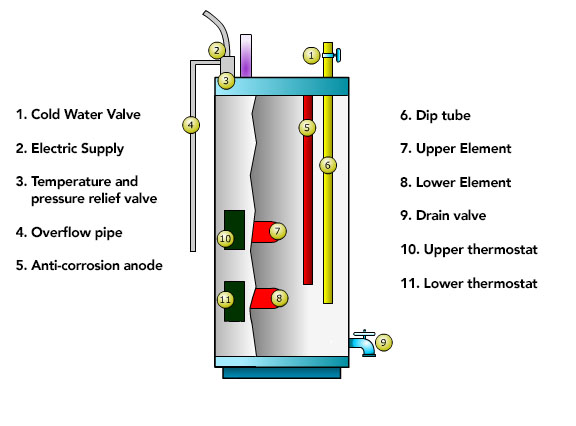
Imagine stepping into a warm, soothing shower after a long day. That comforting experience often relies on a reliable source of hot water, and for many households, that source is an electric tank water heater. These devices have been a staple in homes for decades, providing a steady supply of hot water for various needs.
Understanding Electric Tank Water Heaters
At its core, an electric tank water heater is a simple yet effective appliance. It consists of an insulated tank that stores water, and electric heating elements that heat the water to a desired temperature. Let's break down the key components:
- Tank: The insulated tank is where water is stored and heated. Its size determines the amount of hot water available.
- Heating Elements: These are the electrical components that convert electricity into heat, raising the water temperature.
- Thermostat: This controls the temperature of the water, ensuring it stays within a set range.
- Dip Tube: This tube brings cold water to the bottom of the tank, allowing for efficient heating.
- Anode Rod: This sacrificial rod protects the tank from corrosion, extending its lifespan.
- Pressure Relief Valve: A safety feature that releases excess pressure, preventing tank damage.
How Electric Tank Water Heaters Work
The process is straightforward: cold water enters the tank through the dip tube and is heated by the electric heating elements. The thermostat monitors the water temperature, cycling the heating elements on and off to maintain the desired setting. As hot water is used, cold water replaces it, and the cycle repeats. This constant heating and storage system ensures a continuous supply of hot water.
Advantages of Electric Tank Water Heaters

Electric tank water heaters offer several benefits:
- Lower Initial Cost: They are generally less expensive to purchase and install compared to tankless or gas water heaters.
- Simple Installation: Installation is relatively straightforward, often requiring only basic plumbing and electrical connections.
- Reliability: These heaters have a proven track record of reliability and longevity.
- Consistent Hot Water: They provide a steady supply of hot water, suitable for multiple simultaneous uses.
Considerations and Potential Drawbacks
However, there are some factors to consider:
- Energy Consumption: They continuously heat water, even when not in use, which can lead to higher energy bills.
- Limited Hot Water Supply: The amount of hot water is limited by the tank's capacity, which can be a concern for large households.
- Recovery Time: After the hot water supply is depleted, it takes time for the tank to reheat the water.
- Space Requirements: Tank water heaters require dedicated space for installation.

Choosing the Right Electric Tank Water Heater
Selecting the right electric tank water heater involves considering several factors:
Tank Size
The tank size should match your household's hot water needs. Consider the number of people in your home and your typical hot water usage. Common sizes range from 40 to 80 gallons.
Energy Efficiency
Look for models with high Energy Factor (EF) ratings, indicating better energy efficiency. Features like thicker insulation can also reduce energy consumption.
Warranty
A good warranty can provide peace of mind and protect your investment. Check the warranty coverage for the tank and heating elements.
Features

Some models offer advanced features like vacation mode, which reduces energy consumption when you're away, or smart home integration for remote control.
Installation and Maintenance
Proper installation and regular maintenance are crucial for optimal performance and longevity. Installation should be performed by a qualified plumber or electrician. Regular maintenance includes:
- Flushing the Tank: Periodically drain the tank to remove sediment buildup.
- Checking the Anode Rod: Inspect and replace the anode rod as needed to prevent corrosion.
- Testing the Pressure Relief Valve: Ensure the valve is functioning correctly.
- Inspecting Heating Elements: Check for signs of damage or buildup.
Conclusion
Electric tank water heaters remain a popular choice for many homeowners due to their affordability, reliability, and ease of installation. By understanding their operation, advantages, and considerations, you can make an informed decision and ensure a consistent supply of hot water for your home. With proper selection, installation, and maintenance, your electric tank water heater can provide years of reliable service.
No comments:
Post a Comment
Note: Only a member of this blog may post a comment.